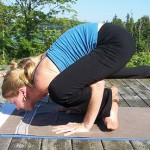 There was an interesting article in yesterdays New York Times about the dangers of yoga. Anyone who has taken a class with me and reads this article would think that I agree with it wholeheartedly. And in some ways I do. But in many ways I don’t. Why shouldn’t we do something just because we might get injured? Isn’t there something to be learned on every level?
There was an interesting article in yesterdays New York Times about the dangers of yoga. Anyone who has taken a class with me and reads this article would think that I agree with it wholeheartedly. And in some ways I do. But in many ways I don’t. Why shouldn’t we do something just because we might get injured? Isn’t there something to be learned on every level?
After class, I asked (Glenn) Black about his approach to teaching yoga — the emphasis on holding only a few simple poses, the absence of common inversions like headstands and shoulder stands. He gave me the kind of answer you’d expect from any yoga teacher: that awareness is more important than rushing through a series of postures just to say you’d done them. But then he said something more radical. Black has come to believe that “the vast majority of people” should give up yoga altogether. It’s simply too likely to cause harm.
There are times when I am teaching and I think I am doing little more than haranguing a class with my repeated warnings about the way the students do yoga. I teach at vinyasa (Flow yoga) studios and honestly have to turn away sometimes as I watch people go through my class. I can tell if they are not happy with what I am doing and really want more. More poses, more speed, more challenge. And to be honest I understand that because I find the pushing and working too hard fun as well. And this might be my ego talking but I think that when I take vinyasa classes I am not in danger of getting injured because I know what I am doing.
Does that mean that I never get injured? Oh how I wish that were the case. At last year’s thanksgiving celebration while performing the cooking marathon that I love so dearly I injured a muscle in my upper left arm. It was as weird an injury as I have had, but what can you do? There it was. But I kept practicing and working through it. Six months later I was back to being pain free. Was this the wisest approach to the injury? I’m not sure but it worked for me. That is about the worst injury I have had in the last six years.
But let’s go back to the beginning of my yoga life and work forward so I can catalogue the injury after injury that I have sustained. Before I begin I want to make it clear that now at 48 years old and a good bit heavier than I was in my ashtanga (a very demanding form of yoga) period, I am pain and injury free in a way I couldn’t have imagined ten years ago. I went to my chiropractor two weeks ago and for the first time since I saw her with what was a severe back injury six years ago, she pronounced me in perfect alignment. Did I mention that I am old and twenty pounds overweight?
I was born with very loose limbs and long muscles. I showed up in yoga at thirty two years old in ok shape. I was overweight and rollerblading to try to take the weight off which wasn’t working so well when a friend of mine turned me on to ashtanga yoga. I was quickly hooked and going six days a week for ninety minutes a day
In six months I was down to 155 pounds, a weight I admit to never wanting to achieve again (I am now 185 and should be 165). Man did I love ashtanga. I always had dreams of being an athlete as a kid and here I was doing fairly amazing physical feats and feeling really good about it. The times article talks about yoga being about letting go of the ego. That wasn’t what I got from my first dance with the practice.
 My first injury was really strange. I had been doing ashtanga for about eight months and I was in a pose called bhuja pindasana. For a couple of weeks I had been feeling a weird pull in my rib cage. In this pose your hands are on the floor with your legs wrapped around your upper arms with the ankles crossed. The second stage of the pose has the head coming down to the floor. So after a couple of weeks of this strain I heard a pop in my ribcage. I tried to do the next pose and there was no way it was happening. I had never experienced anything like the stabbing pain I was getting in my ribcage every minute or so. Spasms of pain wracked my ribs so intensely that I would burst out laughing in response and then wince because the laughing made it worse. Those spasms lasted the rest of that day. Someone told me that I popped an intercostals muscle in the rib cage and I would be back sooner rather than later. In two weeks I was back on the mat.
My first injury was really strange. I had been doing ashtanga for about eight months and I was in a pose called bhuja pindasana. For a couple of weeks I had been feeling a weird pull in my rib cage. In this pose your hands are on the floor with your legs wrapped around your upper arms with the ankles crossed. The second stage of the pose has the head coming down to the floor. So after a couple of weeks of this strain I heard a pop in my ribcage. I tried to do the next pose and there was no way it was happening. I had never experienced anything like the stabbing pain I was getting in my ribcage every minute or so. Spasms of pain wracked my ribs so intensely that I would burst out laughing in response and then wince because the laughing made it worse. Those spasms lasted the rest of that day. Someone told me that I popped an intercostals muscle in the rib cage and I would be back sooner rather than later. In two weeks I was back on the mat.
A while after that I began to develop knee pain that wouldn’t subside. It kept getting worse and unfortunately my teacher at the time suggested that I work through it, that the pain was a rite of passage. The first explosion in my knee occurred two years into the practice; I had a meniscus (the cartilage in the knee capsule between the upper and lower leg) injury that would require surgery. I actually had a plane ticket to go to Mysore, India to study ashtanga a month later, which my Dr. assured me that I would be able to make. Ninety percent of meniscus surgeries see the patients back on their feet in a couple of weeks.
I was greeted after surgery with a pair of crutches and the news that I was in the ten percent. Oh well, so much for India. Why the recovery would be longer was that I tore the entire meniscus off of its moorings and they sewed it back on which is much more complicated than the “clean outs” that they usually do. The next year and a half involved two more surgeries—one more on the first knee, and one on the second. You would think that I might have learned that something was amiss after one surgery but it took me three and a different yoga teacher who looked at me and said “You have no idea what you are doing”.
At that moment I took a step back to reassess what I was doing. Instead of quitting the physical practice I began to study anatomy and physiology, and found a new teacher in order to discover how the body was designed to work compared to how I was actually using it. It was a revelation. I basically had no core strength to support my loose joints and almost all of my movements were coming from my extremities rather than my core—a sure fire recipe for physical destruction.
I started to practice differently learning alignment and building strength in a way that would prevent future injuries. It went very well for a while. Then one day someone showed me a crazy martial arts exercise that I shouldn’t have tried but what can you do? I am not always the sharpest tool in the shed. As I attempted the exercise I heard a loud pop in my groin followed by a searing pain that wouldn’t go away for more than a month. I was like one of the teachers mentioned in the article that could barely move while they taught. This injury is what led me to my chiropractor who I worship. (Tribeca Chiropractic)
Fast forward past six years of a lot of work with the chiro, a lot of conscious attention to my yoga practice, the addition of some fun toys (all hail the bosu ball), and a keen emphasis on core balancing and strengthening exercises.
I apologize for the endless length of this post but I will wrap it up with this—what I don’t like about this article is that it lacks any mention of a student’s responsibility for their own health. We are all here on a path whether we are aware of it or not and we all have things to learn. Injury, and obstinacy in the face of injury, was clearly something I needed to work through. Do I wish I didn’t have to get scars on my knees to learn how to take care of my body? Maybe, but I think it is much more likely that without the injuries and recovery, I would be a fat forty eight year old man who wasn’t paving the road to a happy old age.
So I await the next injury with quiet patience and the knowledge that it and I will heal and carry on.
I’ll finish with a quote from one of my all time favorite teachers—Shri Dharma Mitra. This is from the introduction to his super cool book 608 yoga poses and sums up the situation perfectly.
…students should have a teacher available. The guru has gone to route. He or she knows the journey and is able to guide others. He or she will know which poses are good for you and which to avoid. As students grow spiritually and improve their mental patterns they’ll attract better teachers. Unfortunately there are many certified yoga instructors today who don’t know anything about yoga. But students needn’t worry—everything has a divine purpose. Instructors who don’t know anything attract students who don’t deserve the truth yet. There is a natural order to the world.
